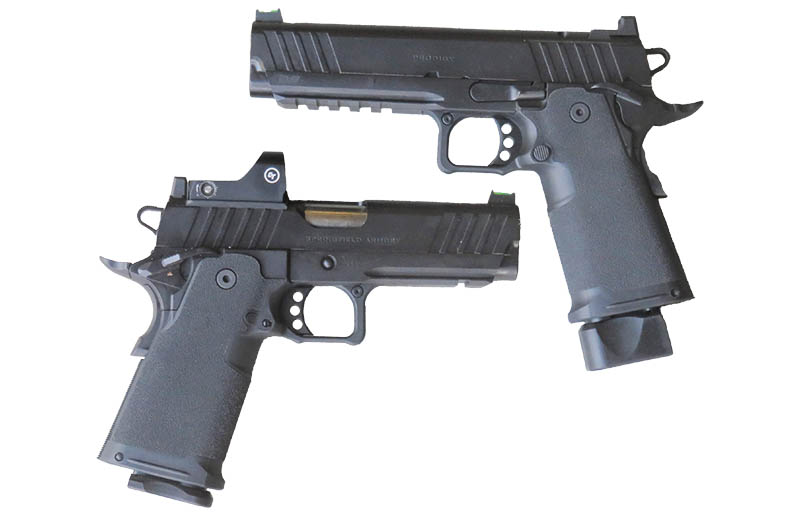The author reviews Springfield Armory’s 2011-style handgun line, including both the Springfield Prodigy 4.25-inch and the 5-inch model.
Any double-stack, hammer-fired 1911-style pistol has become known as a “2011.” And Springfield Armory flipped the 2011’s script with the introduction of the 1911 DS Prodigy in a 4.25-inch barrel Commander-size model and a 5-inch barrel full-size variant. Not only is the full-size version ready to rumble through stages at match competitions, but the more compact 4.25-inch Prodigy takes concealed carry to a whole new level of 1911 performance.
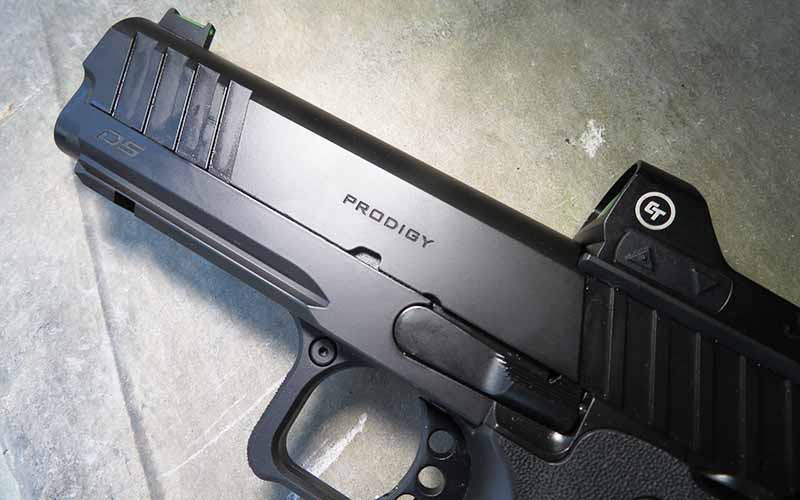
If you compete, you probably already know that STI, which has since morphed into Staccato, coined the 2011 name decades ago, transforming competition shooting and the pistols used. An authentic 2011 is a 1911-style platform with a steel slide and frame, less the grip portion. A polymer grip module bolts onto the steel frame to provide room for the thicker, double-stack magazine. By comparison, the standard 1911 platform uses a single-stack mag, and the grip is integral to the frame.
The sole purpose of double-stack 2011s was and still is to shoot fast and accurately at steel or cardboard targets. They are high-performance, high-end, custom race guns — so expensive you might have to sell an organ. However, with the new Prodigy line, Springfield Armory enables shooters to get into a 9mm double-stack for a lot less, so you can keep your kidney.
Each 1911 DS (DS stands for Double Stack) pistol employs a steel slide and frame comprising the slide rails, the recoil spring inside the dustcover, and the fire-control components. To this, the polymer module is bolted. While that may sound like Springfield Frankenstein-ed the 1911 DS, the polymer grip module blends seamlessly with the steel components. The grip has more girth than a standard 1911 but feels less chubby than some striker-fired double-stack pistol grips. The grip’s texture is like fine sandpaper. I found myself wanting to grip the pistol; it just feels good in the hand. The triggerguard is undercut for a higher grip and less muzzle flip, and the magazine well is flared, so it slurps up the tapered double-stack magazines fast when reloading.
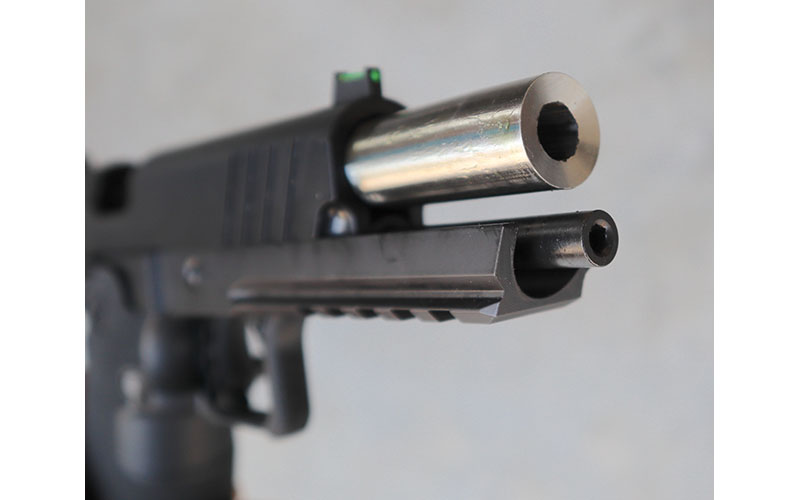
The pistols use a bushing-less bull barrel that flares at the muzzle and mates with the inside of the slide. It’s made with an integral feed ramp, so 9mm cartridges feed smoothly and reliably. The case is also fully supported. Like other Springfield Armory models with this barrel setup, it requires a hex wrench for disassembly (Springfield supplies the wrench). The slide has a traditional dome shape, and coarse slide serrations fore and aft, offering plenty of traction to rack the slide and do a press check. The slide-to-frame fit is tight with no wiggle. Racking the slide or doing a press check, I discovered how smooth and slick it was to manipulate. The Prodigy has a two-piece guide rod that acts like a full-length rod. The back half of the rod is like a GI-length rod but threaded on the end to mate with the second piece. It provides smoother recoil.
The sights are another feature where Springfield pushed the pistol squarely into the 21st century. The front sight post is dovetailed to the slide and houses a green fiber tube, so the front sight pops when aiming. The rear sight is flush with the rear of the slide and serrated to cut glare. It has a U-notch groove. OK, that may seem pretty vanilla, so here is the innovative part: Springfield partnered with Agency Arms to develop an interchangeable optics plate system. The rear sight is part of the optics plate. What I like about this setup is that the plate is half-dovetailed into the slide, which takes the shear force during recoil rather than the screws holding the optic to the gun. The pistols have a Trijicon RMR-footprint optics adapter plate, popular with several other red-dot sight manufacturers.

Controls consist of an extended ambidextrous thumb safety that crisply clicks on and off. The slide stop is inset into the nearly full-length dustcover, yet can be used to rest your support hand thumb. The magazine release button is serrated and slightly extended to make reloads a hair faster than a standard one. The trigger is a three-hole aluminum affair with a curved, serrated face and is adjustable for overtravel. The polymer grip module guides the trigger, making the rearward press smooth. The grip safety has a decent speed bump and an upswept beavertail that keeps beefy hands from being bitten by hammer and slide.
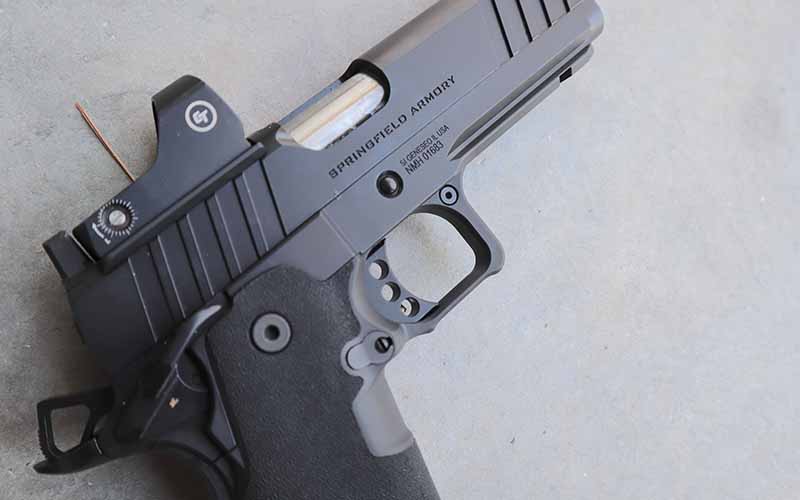
The most finicky component in a 2011 platform is the magazine. Springfield uses DuraMag to build the 17-round flush fit and 20-round extended mags. Springfield also offers a 26-rounder. The floor plate is polymer, and the magazine tube is steel. There are three witness holes at 5, 10, and 17 rounds on the flush fit mag and an extra hole at the 20-round mark on the 20-round extended magazine. Springfield Prodigy magazines will function in Staccato P guns and vice versa.
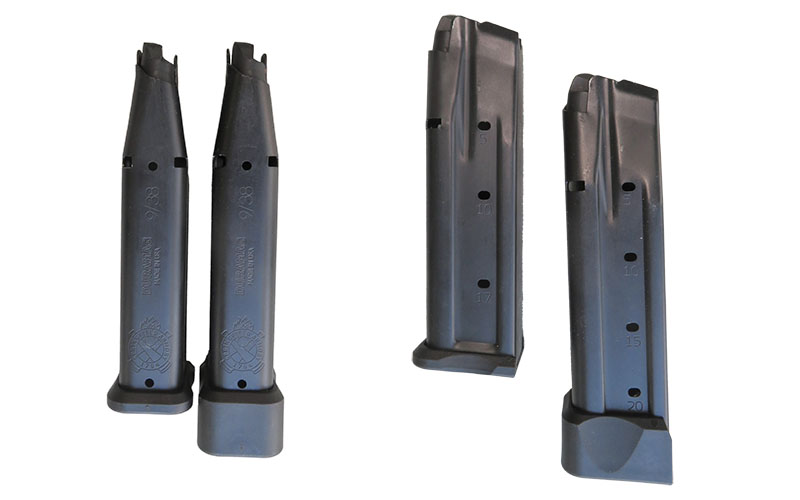
My function testing included both a Springfield Prodigy 4.25- and 5-inch model. Both guns are available with iron sights and optics ready or with a factory-mounted Springfield Hex Dragonfly red dot. I ran iron sights on the 5-inch Prodigy; on the 4.25-inch model, I mounted a Crimson Trace CTS-1250 compact reflex sight with a round 3.25 MOA red aiming dot. The tall Prodigy sights co-witness with the Crimson Trace, and in the event the battery gives up the ghost, you can still use the irons.
I started with speed shooting some Failure to Stop or Mozambique Drills on plain cardboard IPSC/USPSA targets and immediately noticed how smoothly the pistols cycled. The recoil pulse in the 4.25-inch model was soft, and the pistol’s weight enables you to stay on target. The recoil pulse on the 5-inch gun was not as soft, but it was still easy to control. I found these handguns forgiving, which makes you a better shot. I shoot many compact- and full-size striker-fire pistols, so the transition to the Prodigy’s grip felt familiar. However, the trigger was different — in a good way. There was slight takeup on both models until I hit the wall, and the trigger broke at 5.3 pounds on average. Could the pull weight be better? Sure. I want a clean 3.5 to 4 pounds, but that’s just me being hyper-critical. Trigger reset is fast, enabling quicker follow-up shots.

I shouldn’t complain about the trigger pull since I was shooting 5-shot groups at 25 yards that average 1.2 inches with the 4.25-inch red dot-equipped pistol and 2 inches with the 5-inch pistol’s iron sights.
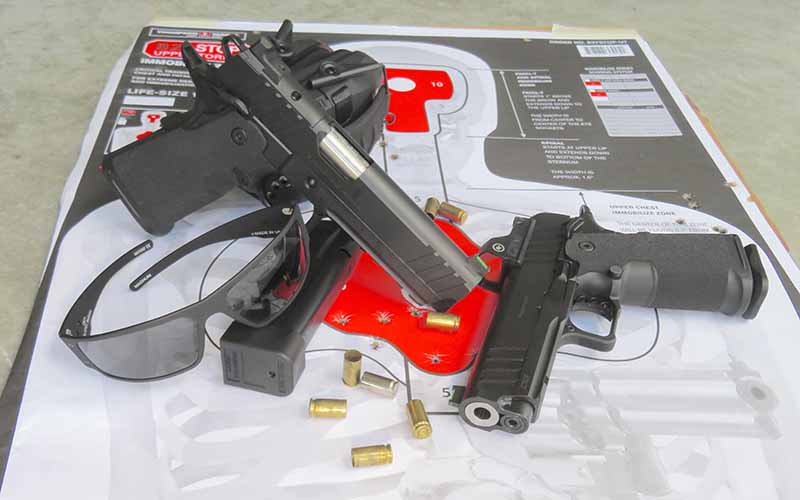
Shooting the 4.25-inch gun was an exercise in precision. A red-dot optic provides a distinct advantage in accuracy. The data from Remington HTP and SIG V-Crown defense ammo showed that my best groups were 1.1 and .97 inches, respectively. Sure, that was using a rest, but shooting offhand, I easily clustered holes center of mass. It liked the inexpensive Federal American Eagle ammo. My best group measured .7 inches! Looking at the Springfield Prodigy 4.25-inch through an EDC lens, I could see myself carrying it. It may be a bit heavier than a single stack, but that is manageable with the right holster and belt.
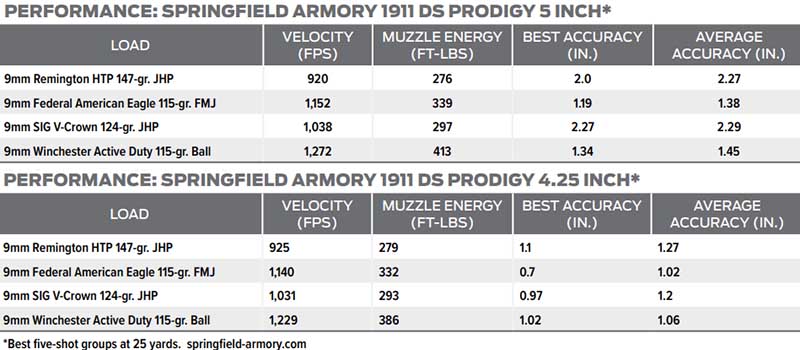
Shooting the 5-inch Prodigy old-school style, meaning iron sights, I didn’t feel disadvantaged. The sights allow fast target acquisition, and the soft recoil ensures faster follow-up shots. The big version also liked the inexpensive 115-grain training ammo from Winchester and Federal, giving me a best group of 1.34 and 1.19 inches, respectively. With the 5-inch model, I almost felt like I was cheating shooting the Mozambique Drill. The heavy pistol chugged through rounds begging me to slap the go switch faster.
Both pistols ran exceptionally well. No issues of any kind were encountered.
The Prodigy is a fast-shooting pistol with an excellent trigger reset and outstanding recoil control. These pistols beg to be run fast and hard. Springfield has a couple of winners here that offer superb value and performance for the price.
Springfield Armory 1911 DS Prodigy 5″ Specs:
- Caliber: 9mm
- Action Type: Semi-auto, short-recoil-operated, SAO trigger
- Overall Length: 8.5 inches
- Overall Height: 5.5 inches
- Maximum Width: 1.2 inches
- Weight Unloaded: 33 ounces
- Barrel: 5 inches, forged stainless steel, match grade, bull
- Frame Finish/Material: Matte black Cerakote/steel
- Slide Finish/Material: Matte black Cerakote/steel
- Grip: Textured polymer
- Magazine: 17+1 and 20+1
- Sights: Green fiber-optic front, black serrated U-notch rear
- MSRP: $1,499
Springfield Armory 1911 DS Prodigy 4.25″ Specs:
- Caliber: 9mm
- Action Type: Semi-auto, short-recoil-operated, SAO trigger
- Overall Length: 7.8 inches
- Overall Height: 5.5 inches
- Maximum Width: 1.2 inches
- Weight Unloaded: 32.5 ounces
- Barrel: 4.25 inches, forged stainless steel, match grade, bull
- Frame Finish/Material: Matte black Cerakote/steel
- Slide Finish/Material: Matte black Cerakote/steel
- Grip: Textured polymer
- Magazine: 17+1 and 20+1
- Sights: Green fiber-optic front, black serrated U-notch rear
- MSRP: $1,499
- Website: springfield-armory.com
Editor’s Note: This article is an excerpt of Gun Digest 2024, 78th edition.
More Handgun Reviews:

Next Step: Get your FREE Printable Target Pack
Enhance your shooting precision with our 62 MOA Targets, perfect for rifles and handguns. Crafted in collaboration with Storm Tactical for accuracy and versatility.
Subscribe to the Gun Digest email newsletter and get your downloadable target pack sent straight to your inbox. Stay updated with the latest firearms info in the industry.
